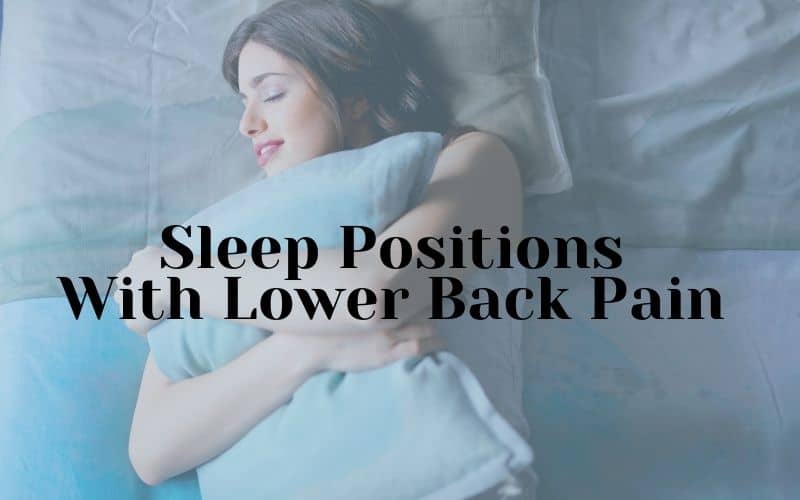You’ve probably experienced the unpleasant effects of sleeping in an improper position if you’ve ever awoken with a tingling arm or achy neck.
The key is alignment: sleeping with your spine in a neutral position relieves stress on your back and neck.
Sleeping on a hard surface is also beneficial.
So, which sleeping positions should you favor and which should you avoid?
From best to worst, here’s a summary of sleep positions with lower back pain results.
Sleep Positions With Lower Back Pain
Some of the best sleeping positions for someone with lower back pain are:
#1. The Best Way To Sleep Is On Your Back.
Lying flat on your back is the ideal position for avoiding back pain.
Even so, many people find it the most difficult way to get a good night’s sleep.
Place one cushion behind your head or neck and another beneath your knees for best spine alignment.
#2. Sleeping On One’s Side Is A Close Second.
The second-best position for avoiding back and neck pain is to sleep on your side with your legs straight.
Because it keeps your airways open, it’s also a beneficial position for snorers or anyone with sleep apnea.
Another sort of side sleeping that is less good for your back is sleeping with your legs bent upwards.
#3. Sleeping On Your Back
Space opens up between the torso and legs when sleeping on an incline, whether with a wedge cushion or an adjustable base, reducing pressure build-up on the spine.
Therefore, if you can’t sleep due to lower back pain, then you should try these sleeping positions regularly for better results.
While certain sleeping positions can relax back pain, some of them could be the reason behind those.
Wrong Sleeping Positions For Back Pain
Sleeping on your stomach is the worst position for your spine because it flattens the natural curvature of your spine, putting the most strain on the muscles and joints.
In addition to causing neck and upper back pain, sleeping on your stomach compels you to turn your neck.
Therefore, there can be an increase or worsen conditions of lower back pain when lying on the stomach.
How To Sleep With Lower Back Pain And Sciatica?
Impingement of the sciatic nerve causes sciatica.
A herniated disc in your lower back is the most common reason.
With sciatica, getting a decent night’s sleep might be challenging.
Certain positions can put pressure on your inflamed nerve, causing symptoms to flare up.
Some positions, on the other hand, are less prone to induce pain.
● You Have My Support- Sleeping on your side may help relieve the discomfort by relieving pressure on your inflamed nerve.
● Between Your knees, Place A Pillow- Keeping your pelvis and spine in a neutral position might be as simple as putting a pillow between your knees.
● Position Of The Fetus- The fetal position allows space between your vertebrae to open up, which may help relieve back discomfort caused by a herniated disc.
● Underneath Your Lower Back, Use A Towel Or A Pillow- By decreasing the distance between your back and the mattress, placing a towel or small pillow under your lower back can assist keep your spine in a neutral position.
● Sleeping On The Ground- Your spine may bend out of alignment as a result of soft surfaces. You might discover that sleeping on the floor helps you maintain appropriate spinal alignment.
Is Sleeping In A Recliner Good For Sciatica?
Getting into and out of a reclining chair is simpler for some persons with back problems than getting into and out of bed.
If you sleep on a reclining chair, a pillow behind your lower back can provide support.
Moreover, sciatica can be avoided by maintaining good posture.
The lower back is put under a lot of strain while you sit.
As a result of the bad sitting position, nerves around your spine may be compressed.
You should invest in a nice reclining chair if you want to avoid sciatica discomfort.
A recliner is superior to a standard chair for supporting your spine and lower back.
Tips For Sleeping Position For Middle Back Pain
Back pain can make it difficult to get through the day, but it can also make getting a decent night’s sleep difficult.
Finding a comfortable position to fall asleep in might be difficult. You may not even be able to get in and out of bed without discomfort.
If you’re having difficulties sleeping due to back discomfort, try these strategies on sleeping positions with lower back pain to make it a bit easier.
● Certain sleeping positions might help ease your back discomfort, so select one that is most comfortable for you.
● Your body type will determine the type of mattress you require.
● Sleeping on your stomach puts a lot of strain on your back, so avoid it.
● It may seem self-evident, but be extra cautious when getting in and out of bed.
● Regular exercise is an excellent strategy to improve the quality of your sleep.
● Yoga or rigorous stretching helps to alleviate low back pain. It can also help you sleep better and relieve stress.
The lower back supports the whole body weight and it can range from mild to severe.
Understanding the link between sleep and back pain can help contribute to healing and recovery.
Conclusion
Sleep is vital to your health and is a crucial component of your general well-being.
Many people suffering from sciatica find lying down to be excruciating.
In general, sleeping on one’s side or back is preferable to sleeping on one’s stomach.
Therefore, it is important to avoid sleep positions with lower back pain and replace them with the ones which provide comfort.
